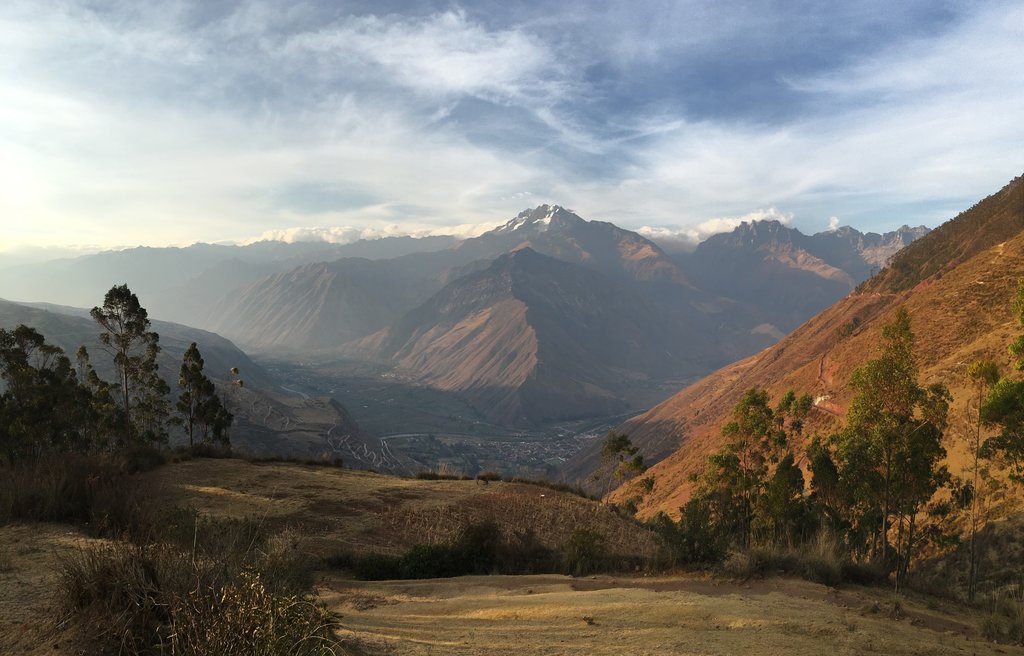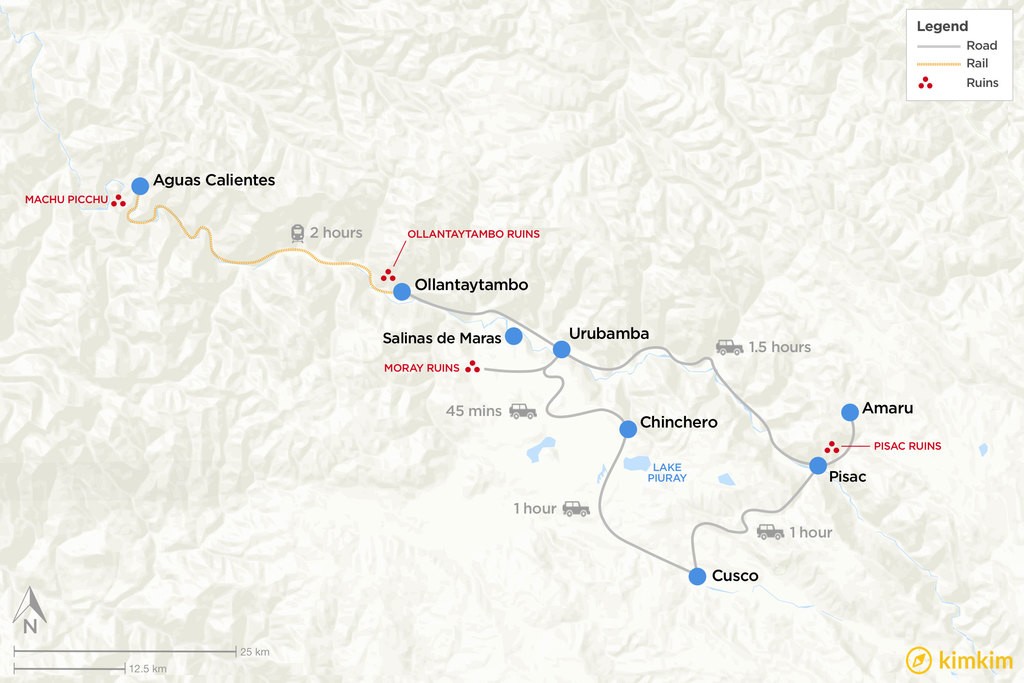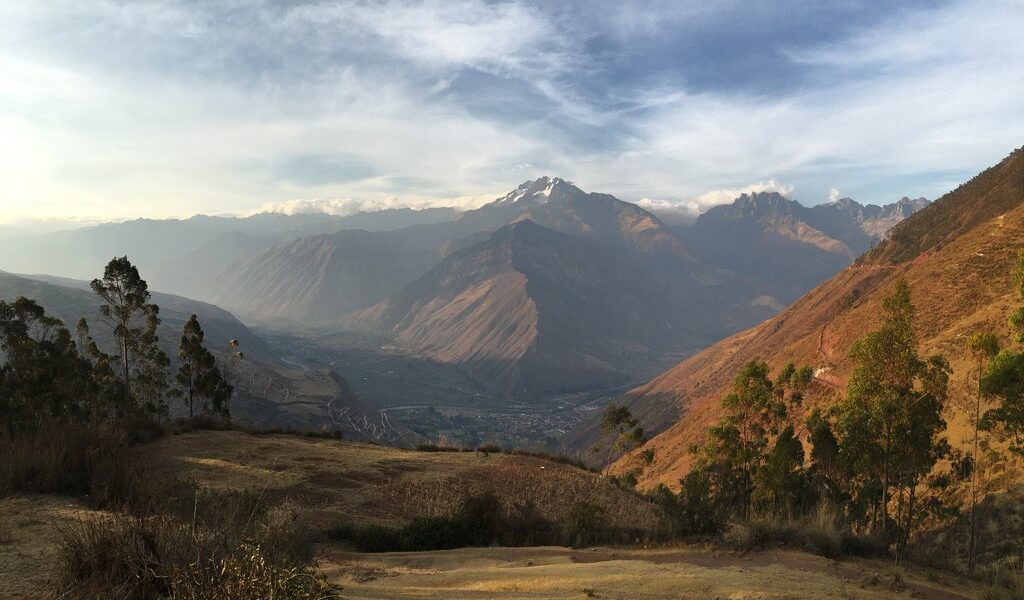
The Sacred Valley is one of Peru’s most popular destinations. Once the cultural and spiritual heartland of the Inca, it is chock-full of ancient ruins, picturesque villages and stone footpaths. Machu Picchu may be the main attraction, yet one could spend days exploring the cultural highlights and ancient ruins of the Sacred Valley of the Urubamba River.
## Highlights of the Sacred Valley: An Expanded Exploration
The Sacred Valley of Peru, a land steeped in history and natural beauty, beckons travelers with its iconic landmarks and hidden gems. This region, cradling the legendary Machu Picchu, offers a diverse tapestry of experiences that extend far beyond the well-trodden tourist paths. From awe-inspiring ruins perched high in the Andes to vibrant markets brimming with local culture, the Sacred Valley promises an unforgettable adventure.
Here, we delve deeper into the highlights of this remarkable destination, providing you with an enhanced guide to make the most of your journey.
* **Machu Picchu: A Journey to the Lost City:** Embark on an unforgettable pilgrimage to the world-famous ruins of Machu Picchu, a breathtaking citadel perched at an astonishing 3000 meters above sea level. Feel the weight of history as you wander through its ancient stone structures, marveling at the ingenuity and artistry of the Inca civilization. The sheer scale and architectural brilliance of Machu Picchu will leave you in awe, a testament to a bygone era.
* **Maras Salt Mines: A Kaleidoscope of Colors:** Prepare to be mesmerized by the multi-colored salt pools at the salt mines of Maras. This unique landscape, carved into the mountainside, showcases a centuries-old tradition of salt extraction. Witness the intricate network of terraced ponds, each shimmering with different hues, creating a stunning visual spectacle. The Salinas de Maras offer a glimpse into the ancient techniques of resource management and the enduring connection between the local communities and their land.
* **Ollantaytambo: A Night in an Ancient Village:** Immerse yourself in the charm and tranquility of Ollantaytambo, an ancient village that has stood the test of time. Spend the night within its historic walls, allowing yourself to be transported back to the days of the Inca Empire. Explore the well-preserved ruins, wander along the cobblestone streets, and soak in the authentic atmosphere of this captivating settlement. Ollantaytambo offers a unique opportunity to connect with the past and experience the enduring spirit of the Sacred Valley.
* **Local Communities and Vibrant Craft Markets: A Cultural Immersion:** Venture beyond the main attractions and discover the heart and soul of the Sacred Valley by exploring local communities and visiting the numerous vibrant craft markets. Engage with the friendly locals, learn about their traditions and customs, and witness their artistry firsthand. From intricately woven textiles to handcrafted ceramics, these markets offer a treasure trove of unique souvenirs and a deeper understanding of the region’s rich cultural heritage.
* **Pisac, Ollantaytambo, and Chinchero: Unveiling the Valley’s Hidden Treasures:** While Machu Picchu undoubtedly steals the spotlight, don’t overlook the smaller yet equally impressive ruins of Pisac, Ollantaytambo, and Chinchero. Each site boasts its own unique charm and historical significance, offering a diverse perspective on the Inca civilization. Explore the agricultural terraces of Pisac, the formidable fortress of Ollantaytambo, and the captivating blend of Inca and Spanish architecture in Chinchero. These lesser-known ruins provide a more intimate and nuanced understanding of the Sacred Valley’s rich history.
## An In-Depth Overview of the Sacred Valley
The Sacred Valley of Peru, the gateway to the majestic Machu Picchu, stands as a testament to the rich history and breathtaking natural beauty of South America. More than just a stepping stone to the famed ruins, the valley itself boasts an astounding array of activities and attractions, ranging from well-preserved historical sites to secluded, off-the-beaten-path villages. To truly appreciate the essence of this region, allocate several days for thorough exploration.
The Sacred Valley, meticulously carved by the relentless flow of the Rio Urubamba, stretches majestically from the vibrant city of Cusco to the awe-inspiring Machu Picchu. Within its embrace lie the former Inca strongholds of Urubamba, Pisac, Chinchero, and the captivating Ollantaytambo. Travelers who venture beyond the main thoroughfares and into the embrace of the surrounding foothills will be rewarded with glimpses into the authentic rhythm of rural village life and the opportunity to embark on exhilarating treks along lesser-known Inca trails, each whispering tales of a bygone era.
Most discerning travelers dedicate a minimum of a couple of days to immerse themselves in the exploration of the Sacred Valley’s primary sites and attractions before proceeding to the much-anticipated visit to Machu Picchu. For those who seek to simply meander at their own pace, the Sacred Valley’s trove of historic towns, kaleidoscopic markets, and captivating, yet less-visited ruins, offers a wealth of experiences capable of captivating your attention and filling your days with wonder.
Presented below is a comprehensive compendium of the various highlights that the Sacred Valley has to offer, complete with invaluable tips and insights to assist you in maximizing the enjoyment and enrichment of your adventure.
## Cusco: Gateway to the Sacred Valley
Cusco serves as the primary gateway for travelers venturing into and out of the Sacred Valley. The most common route is by flight from the bustling metropolis of Lima or overland via bus or train from the southern reaches of Peru. Nestled within a high-altitude valley embraced by the Andean foothills at a staggering 3,400 meters above sea level, it is highly recommended that you spend a couple of days acclimatizing to the elevation before embarking on any strenuous, high-altitude adventures. This will allow your body to adjust gradually, minimizing the risk of altitude sickness and ensuring a more comfortable and enjoyable experience.
This historic colonial city, once the proud capital of the vast Inca Empire before the Spanish conquest in 1533, now pulsates with vibrant plazas, an eclectic assortment of shops, meticulously restored churches, and an endless selection of hotels, restaurants, and bars to cater to every taste and budget. Cusco provides the perfect setting to both begin and conclude your unforgettable journey through the Sacred Valley.
Beyond the city limits, four nearby ruins offer the perfect excuse for an enriching day trip. The most famous of these is undoubtedly Sacsayhuamán, an expansive stone complex that showcases the remarkable engineering skills of the Incas. It is easily accessible via a short, albeit steep, walk from Cusco. To maximize your time and experience all four ruins in a single day, consider hiring a local taxi to transport you to the furthest site, Tambo Machay, and then plan to hike the scenic 8km back to Cusco, allowing you to soak in the breathtaking landscapes along the way.
## Machu Picchu: Unveiling the Lost City of the Incas
A visit to Machu Picchu is an unavoidable and essential part of any Sacred Valley itinerary. This captivating site is the region’s undisputed star attraction, drawing visitors from all corners of the globe. Reaching Machu Picchu requires one of two options: a multi-day trek along the historical footpaths painstakingly crafted by the Incas, or a more convenient short train journey originating from either Cusco or the charming town of Ollantaytambo.
The train delivers travelers to Aguas Calientes, a petite village nestled at the base of the mountain upon which Machu Picchu resides. From Aguas Calientes, you have the option of taking a bus up to the entrance of Machu Picchu or challenging yourself with a steep, invigorating hike that typically takes 45 minutes or more, depending on your individual fitness level.
The optimal time to visit Machu Picchu is undoubtedly at the break of dawn, as the rising sun bathes the ancient stone walls and corridors in a warm, golden light, creating a magical atmosphere. Arriving early also allows you to beat the inevitable crowds and experience the site in relative tranquility. After dedicating ample time to exploring Machu Picchu’s primary ruins, those yearning for breathtaking panoramic views of the entire site and the majestic surrounding mountains can embark on a rewarding hike up Huayna Picchu, the iconic spire of rock that dramatically towers above Machu Picchu’s northern end. The entrance to the Huayna Picchu trail is located within Machu Picchu’s main ruins. Be aware that space on this narrow stone pathway is limited, especially during the peak tourist season, so it is highly recommended that you reserve your spot well in advance to avoid disappointment.
After dedicating a full day to exploring the wonders of Machu Picchu, you can choose to either spend the night in Aguas Calientes, allowing you to reflect on your experience and further explore the town, or catch a train back to Cusco or Ollantaytambo the same day, providing you with convenient transportation to your next destination.
## Pisac Ruins & Market: A Tapestry of Culture and History
Departing from Cusco, the majority of travelers make their way to Pisac, a destination renowned for its impressive terraced ruins and its vibrant, colorful market. From Pisac, they typically continue on to either Urubamba or Ollantaytambo, further exploring the treasures of the Sacred Valley. The Pisac market, a bustling hub of activity, comes alive on Tuesdays, Thursdays, and Sundays, drawing crowds eager to browse the countless stalls overflowing with local produce and handicrafts.
In addition to the market’s allure, Pisac also boasts an impressive Inca citadel strategically perched on the hillside overlooking the town, as well as beautifully crafted agricultural terraces that offer stunning panoramic views over the entire Sacred Valley. Plan to spend at least half a day immersed in the exploration of the market, the terraces, and the captivating ruins.
## Ollantaytambo Ruins & Village: A Living Inca Legacy
While both Pisac and Urubamba are undeniably worth visiting, the charming town of Ollantaytambo, with its picturesque cobblestone streets, quaint shops, and stunning location, makes it an exceptionally attractive base for exploring the entirety of the Sacred Valley. From Ollantaytambo, numerous day hikes can be easily accessed directly from town or via a short, convenient taxi ride. One of the most rewarding options is the steep hike up to the fortress and temple complex that looms dramatically above the town, offering breathtaking views and a glimpse into the strategic importance of Ollantaytambo during the Inca era.
## Chinchero Ruins & Market: A Blend of Inca and Colonial Heritage
Perched at an elevation of 3,700 meters, the village of Chinchero possesses a slightly more remote feel compared to Ollantaytambo or Pisac, but its unique charm and cultural significance make it well worth the effort to visit, provided you can manage the altitude. This traditional Andean village showcases impressively crafted Incan terraces and walls, a beautiful Spanish colonial church built atop ancient Incan stones, and a vibrant, colorful Sunday market that offers a glimpse into the local way of life. Chinchero also offers sweeping views of the surrounding mountains and serves as the starting or ending point for several excellent day hikes that wind through the picturesque landscape.
## Salinas de Maras (Salt Mines): A Unique Landscape
The salt pans located near the village of Maras stand out as one of the most unique and visually captivating attractions in the Sacred Valley. Since the time of the Inca civilization, community members have ingeniously diverted mineral-laden spring water into a series of shallow, terraced ponds. The water then evaporates under the Andean sun, leaving behind valuable salt deposits. These ponds, meticulously built into the side of the valley, transform into varying shades of red and white, creating a stunning spectacle for photographers and a fascinating place to explore for a couple of hours.
## Moray Crop Circles: A Testament to Inca Agricultural Innovation
The circular terraces of Moray offer a fascinating glimpse into the advanced agricultural practices of the Inca civilization. These unique formations were reportedly used as testing grounds for growing different varieties of crops at varying altitudes and microclimates. The ruins are both beautiful and unique, making them an engaging and intellectually stimulating visit for those with extra time in their Sacred Valley itinerary. For the more adventurous, consider incorporating a visit to Moray into a thrilling mountain biking route that also includes a stop at the nearby Maras Salt Mines, combining history, culture, and adrenaline-pumping adventure.
## Getting Around the Sacred Valley: A Transportation Guide
Navigating the Sacred Valley offers several options, each catering to different preferences and budgets.
### Taxi:
Taxis provide a convenient way to get around Cusco and can be hired for transportation to and from Urubamba and other destinations down the valley. Taxis are readily available near the Plaza de Armas square in the heart of Cusco.
### Private Car / Van:
Opting for a private car or van is an excellent choice for exploring the Sacred Valley, especially when venturing to remote communities nestled in the surrounding mountains. This option is best organized through reputable local tour operators.
### Bus:
Public buses are available and offer an inexpensive mode of transportation, but they may not be the most efficient option for those seeking to maximize their limited time in the region.
### Train:
For most travelers, a train journey to or from Machu Picchu is an integral part of the Sacred Valley experience. The train ride, following the meandering path of the Urubamba River as it winds its way through the valley, is an unforgettable highlight in itself.

B-2136

